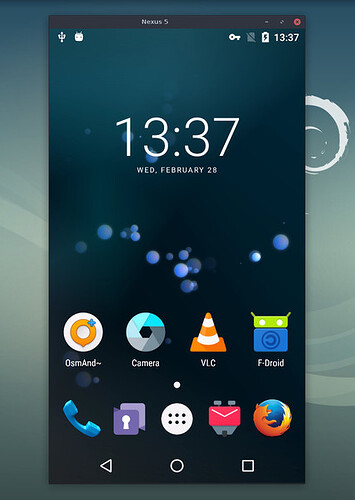This application mirrors Android devices (video and audio) connected via USB or over TCP/IP, and allows to control the device with the keyboard and the mouse of the computer. It does not require any root access. It works on Linux, Windows and macOS.
$ yay scrcpy
Started to use scrcpy a little while ago.
(using it a lot for 2step login codes | copy/paste)
Fast and clear view of the phone.
- Handy : to have a long enough cable for quick physical acces (biometric actions, etc)…
There are many posibilities (see github).
info : Monitor screen is not blanking when scrcpy is running
I use it simple just like this :
$ scrcpy
OUTPUT searching for adb devices.
$ scrcpy
scrcpy 2.7 <https://github.com/Genymobile/scrcpy>
INFO: ADB device found:
INFO: --> (usb) XXXXXXXXXX device moto_g_6__plus
/usr/share/scrcpy/scrcpy-server: 1 file pushed, 0 skipped. 144.9 MB/s (71200 bytes in 0.000s)
[server] INFO: Device: [motorola] motorola moto g(6) plus (Android 13)
INFO: Renderer: opengl
INFO: OpenGL version: 4.6.0 NVIDIA 550.120
INFO: Trilinear filtering enabled
INFO: Texture: 1080x2160
tint2 executer script.sh (icon in the panel for on/of status)
#!/bin/bash
### Show icon [on | of] status, for tint2 panel.
# Define the Unicode icon characters
icon_running="🟢"
icon_not_running="🔴"
# Define the colors for the active and inactive states
color_active="#00FF00"
color_inactive="#808080"
# Check if scrcpy is running
scrcpy_count=$(pgrep -x "scrcpy" | wc -l)
if [ "$scrcpy_count" -gt 0 ]; then
echo "<span foreground='$color_active'>$icon_running</span>"
else
echo "<span foreground='$color_inactive'>$icon_not_running</span>"
fi
Tint2 executer con.fig
# Executor 8
execp = new
execp_name = SCRCPY
execp_command = ~/bin/scrcpy_systray.sh
execp_interval = 3
execp_has_icon = 0
execp_cache_icon = 1
execp_continuous = 0
execp_markup = 1
execp_monitor = primary
execp_tooltip = L:Start M:Stop
execp_lclick_command = scrcpy
execp_rclick_command =
execp_mclick_command = killall scrcpy
Prerequisites
The Android device requires at least API 21 (Android 5.0).
Audio forwarding is supported for API >= 30 (Android 11+).
Make sure you enabled USB debugging on your device(s).
*For more : github page | man page $ man scrcpy *
![]()
